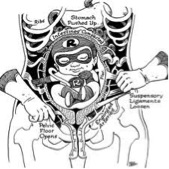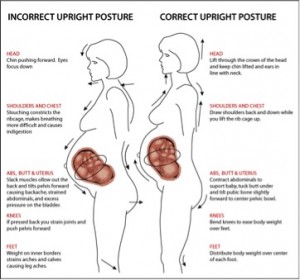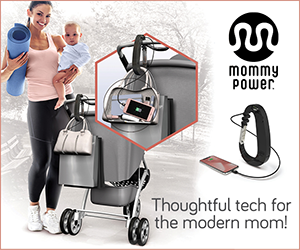A bun in the oven AND a pain in your buns!
Expecting a baby can be an exciting time, but it can also be full of new aches and pains for the mommy to be! Back pain is one of the most common side effects of pregnancy, and up to 80% of pregnant women complain of moderate to debilitating back and leg pain. Today’s blog post is going to cover why back and posterior pelvic pain occurs in pregnancy and how the expectant mother can manage this pain and keep herself active throughout her entire pregnancy.
Dear Baby: why are you making my back hurt!?
Back pain and posterior pelvic pain during pregnancy is related to a number of factors. Some women will experience lower back pain with the onset of pregnancy, while others may not feel these aches until the third trimester. More amazingly, there are some lucky women who will not feel pain at all (and don’t we love them for it!). So, for those of you who DO have pain, what causes it pain to occur?
Beginning in the first trimester, the pregnant women will start to produce a hormone known as ‘relaxin’. The effect of relaxin is to soften and loosen the ligaments of the pelvis in preparation for the delivery. Relaxin creates this “softening” of the ligaments by producing and remodeling collagen, increasing elasticity and the relaxation of all muscles, tendons and ligaments. Unfortunately, hormones cannot target ONLY the ligaments of the pelvis. The end result is a direct negative effect of the strength of your body’s collagen. Don’t fret- ligamentous laxity is NORMAL during pregnancy and is necessary for a natural delivery; however, it is a main cause of back pain during pregnancy.
 |
In addition to the increasing production of relaxin, your uterus is growing and this causes a few things to occur. First, the growing fetus changes your center of gravity. This alters your posture and, thus, the “normal” position of your spine changes. Increased pressure is added to the spinal joints as your weight increases and your center of gravity shifts forward. With these changes, you are forced to change the way you act – the way you sit, stand, reach for your coffee mug in the morning, etc. This change in behavior causes new and often underused postural muscles to become increasingly active, which can cause seeming simple movements to lead to painful sprains and strains. Additionally, to support your growing belly, your abdominal muscles are forced to expand. With this, these muscles lose some of their ability to keep the spine erect and stable. This lack of stability, added to the change in center of gravity, are what forces your posture to change, ultimately leading to those pregnancy aches and pains.
Wait, there’s more! As your baby grows, the weight of the fetus can put pressure on the nerves that lie in your pelvis. This can cause localized pain in the back, as well as shooting pains into the buttocks and down the legs. Pain below the knee is rare.
If this is not your first pregnancy, there are additional concerns regarding your back pain. If you experienced lower back pain with your previous pregnancies, the prevalence of back pain with additional pregnancies is increased and the onset of these symptoms tend to begin earlier. As well, additional children, especially young ones that require more physical attention, can lead to back pain as lifting, carrying, bathing and overall care for them becomes more strenuous on your back as you get bigger.
Dear Doctor: how can I manage my pain naturally and best support my baby?
- Maintaining good posture in a STANDING position:
-Hold your head up straight with your chin pulled in. Do not tilt your head forward, backward, or sideways – your earlobes should be in line with the middle of your shoulders when looking at your side.
-Keep your shoulder blades back and your chest forward – imaging your shoulder blades are being pulled together and down your back.
-Keep your knees straight, but not locked!
-Pull your stomach in and up as much as possible! Do not tilt your pelvis forward or backward and keep your buttocks tucked in.
-Point your feet in the same direction, with your weight balanced evenly on both feet. The arches of your feet should be supported with low-heeled (but not flat!) shoes to decrease the stress on your back. Many women find custom orthotics a source of relied during pregnancy.
-Avoid standing in the same position for a long period of time. If you must stand for long periods, elevate one foot at a time by resting it on a foot stool. After several minutes, switch your feet to elevate the other foot. If standing in front of a counter or table, adjust the height of the table to a comfortable level.
 |
2. Maintaining good posture in a SITTING position:
-Sit up with your back straight and your shoulders rolled back – your buttocks should contact the very back of the chair.
-Use a lumbar support/roll at the curve of your back!! I highly recommend this to support your seated posture, especially while pregnant!
-If you choose NOT to use a lumbar support, or are visiting somewhere and do not have the option, follow these guidelines:
-Sit at the end of your chair and slouch completely.
-Draw your body up and accentuate the curve of your back as far as possible – hold this position for a few seconds. Now, release this position slightly, I suggest 10 degrees), and you should be in a good sitting posture.
-Your body weight should be distributed evenly on both hips, do not to cross your legs or shift your weight from side to side, and place your feet flat on the floor. In this position, your knees and hips should be at right angles. If this is not the case, use a stool to prop your feet up, or, if your chair is adjustable, lower or raise your chair to find the best position.
-Try to avoid sitting in the same position for more than half an hour – take standing and stretching breaks frequently!
-When sitting in a chair that rotates or pivots, be conscious of rotating your entire body as a single unit – do not twist at the waist (what waist!?).
-When standing up from a seated position, move to the front edge of your chair and stand up by straightening your legs. Avoid bending forward at the waist.
Others Who Viewed This
3. Exercise:
-Bird Dog Extensions: As I mentioned earlier, during your pregnancy your abdominal muscles become increasingly lax in order to accommodate the growing uterus. Your back muscles compensate by working much harder than normal. Lower back extensions, performed properly, are safe to perform during your pregnancy and act to strengthen your back muscles to handle their increasing role.
Get down on your hands and knees with an exercise mat underneath you for comfort. Keep your elbows slightly flexed and your back straight. Brace your abdominal muscles before attempting any movements to help support your spine. Extend your right arm out in front of you up to shoulder height. At the same time, extend your left leg out behind you up to hip height. Hold this position for 5 seconds and return to the starting position. Repeat 10-20 times, switching sides with each 5 second count.
-Pelvic Tilts: This exercise acts to strengthen abdominal muscles, which helps to relieve back pain and improve your posture. This exercise is best done on an exercise ball.
Sit on the ball with your feet shoulder-width apart and your feet flat on the floor. Contract your abdominal muscles (again, bracing as if you are about to be punched in the stomach!) and rotate your pelvis so that your tailbone is pointing towards the floor. Hold for 5 seconds, release and repeat 10-20 times. This is an important exercise to help with the delivery of your baby – if you require assistance to learn this exercise, seek out a personal trainer or spine care professional.
-Swimming/Water Exercises: Because water supports your body weight, swimming and prenatal water aerobics classes allow you to get a great full-body workout while relieving pressure from your back and other joints. Check with your local community centers for classes, or seek out advice from a personal trainer. Take a dip, float around in that maternity bathing suit, and enjoy the freedom from your additional weight for a short while!
-Cat Stretch: Your lower back is not the only cause of pain during pregnancy! As your breasts become fuller, the additional weight in the chest area can pull at your upper spine, creating painful, sometimes pinching, pressure. This stretch originated in yoga disciplines and helps to relieve upper back tension.
Get down on your hands and knees (again!) and keep your back straight. Gently drop your head down and round your back, while tilting your pelvis so that your tailbone is pointing towards your nose. Hold for 10 seconds, return to the starting position and repeat.
4. Chiropractic Care:
Chiropractors adjust misaligned joints, especially in the spine, to relieve stress on nerves and promote healing throughout the body. According to numerous scientific studies, chiropractic care is extremely effective in treating pregnancy-related back and posterior pelvic pain. One specific study published in the journal Obstetrics and Gynecology found that 70% of pregnant women receiving chiropractic care achieved long-term relief from pain.
Chiropractors often treat women throughout their pregnancies, right up until delivery! Your chiropractor will do a thorough assessment and convey a diagnosis and individualized treatment plan to you. Specific interventions used by chiropractors during a patient’s pregnancy include spinal or joint manipulation (chiropractic adjustments), joint mobilization, massage and other soft tissue relaxation techniques, exercise programs and education on ergonomics, posture, and body mechanics. Some chiropractors will also make recommendations with regards to self-management, lifestyle, changes in daily activity performance, as well as nutrition guidance.
5. Supportive devices:
Along with the lumbar support I recommended earlier, many pregnant women find relief in maternity support belts. These thick elastic bands are worn around the hips and under the belly. They act to cradle your belly and support your lax abdominal muscles. These can be especially useful if your job requirements include standing for long periods.
Maternity belts come in all shapes in sizes and can vary widely. You can purchase a belt through your chiropractor (many, especially those with a keen interest in treating pregnant patients, will have them on hand in their offices) or through the Canadian Memorial Chiropractic College’s book store and supply center.
Wishing you all an easy and pain-free pregnancy!
Have a question for Dr. Shaila? E-mail her.



